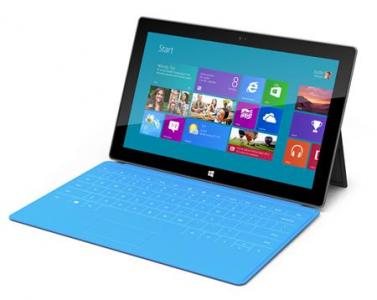(Reuters) – Microsoft Corp introduced its own line of tablet computers on Monday at a much-hyped press event in Los Angeles, marking a major strategic shift for the software giant as it struggles to compete with Apple Inc and re-invent its aging Windows franchise.

The new tablet line, named Surface, includes a consumer device aimed directly at the Apple iPad, and another, larger machine designed to compete with lightweight laptops. Both include a keyboard that doubles as a cover, and both will be powered by versions of the new Windows 8 operating system.
The move breaks with Microsoft’s operating model of the past 37 years, which has relied on computer manufacturers to make and market machines running Windows. It could throw the world’s largest software company into direct competition with its closest hardware partners such as Samsung Electronics Co Ltd and Hewlett-Packard Co.
However, the success of Apple in recent years has underscored the benefits of an integrated approach to hardware and software, and Microsoft Chief Executive Steve Ballmer said on Monday that the company “didn’t want to leave anything uncovered” as it rolled out Windows 8.
The new software is the biggest overhaul of Windows in years, and features a new touch-friendly interface dubbed “Metro”. It is scheduled to be available for the Christmas shopping season.
The lighter, thinner version of the Surface tablet, built on an Nvidia Corp chip designed by ARM Holdings, will be the first to market at the same time as the general release of Windows 8, and will feature Microsoft’s popular Office suite of applications.
It is comparable to Apple’s new iPad, heavier but slightly thinner. It has a 10.6 inch screen and comes in 32GB and 64GB memory sizes.
A second, heavier tablet aimed at the new generation of lightweight laptops called “ultrabooks”, running on traditional Intel Corp chips, will come in 64GB and 128GB models. That will be available about three months after the ARM version, Microsoft said.
The company gave no details on pricing, except that they would be competitive with comparable ARM tablets and Intel-powered Ultrabooks. They will be on sale online and in Microsoft’s new brick-and-mortar stores in the United States.
Microsoft shares rose 0.8 percent in after-hours trading, making up for a 0.6 percent drop to $29.84 in the regular Nasdaq session.
Industry watchers were generally impressed by the devices’ specifications, but doubted they were a sure-fire hit.
“I don’t see this as an iPad killer, but it has a lot of potential,” said Sarah Rotman Epps, an analyst at tech research firm Forrester. “This raises more questions than answers. The story that Microsoft told today was incomplete. They focused on the hardware innovation but didn’t talk about the services, the unique Microsoft assets that could make this product amazing.”
Contrary to expectations, Microsoft made no mention of integrating content and features from its top-selling Xbox game console, the Skype video calling service it bought last year, or Barnes & Noble’s Nook e-reader, its new partner in the electronic books market.
FOLLOWING APPLE
Sales of tablets are expected to triple in the next two years, topping 180 million a year in 2013, easily outpacing growth in traditional PCs. Apple has sold 67 million iPads in two years since launch.
Apple, which makes both hardware and software for greater control over the performance of the final product, has revolutionized mobile markets with its smooth, seamless phones and tablets. Rival Google Inc may experiment with a similar approach after buying phone maker Motorola Mobility this year.
Making its own hardware for such an important product is a departure for Microsoft, which based its success on licensing its software to other manufacturers, stressing the importance of “partners” and the Windows “ecosystem.”
“The question is why is Microsoft doing it?,” said Michael Silver, an analyst at tech research firm Gartner. “Lack of faith in the OEMs (computer makers)? There’s definite risk here as Microsoft increasingly competes with its customers.”
Microsoft stressed that “OEMs will have cost and feature parity on Windows 8 and Windows RT,” meaning that it would not hold back any features from other hardware makers’ Windows tablets.
When it has ventured into hardware, the Redmond, Washington-based company has had a mixed record.
Apart from keyboards and mice, the Xbox game console was its first foray into major manufacturing. That is now a successful business, but only after billions of dollars of investment and overcoming problems with high rates of faulty units – a problem which was nicknamed the “red ring of death” by gamers.
The company’s Microsoft-branded Zune music player, a late rival to Apple’s iPod, was not a success and its unpopular Kin phone was taken off the market shortly after introduction.
The company killed off a two-screen, slate-style prototype of a tablet device called Courier later that year, saying the technology might emerge in another form later on.
(Reporting By Lisa Richwine in Los Angeles, Writing by Bill Rigby in Seattle; Editing by Bernard Orr and Richard Pullin)





